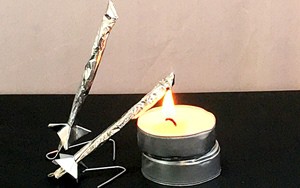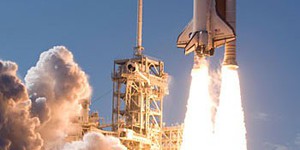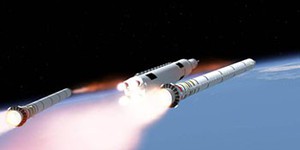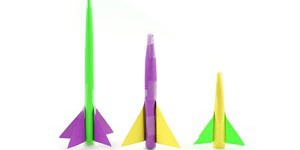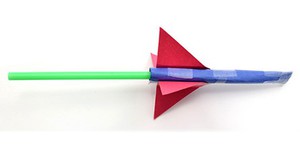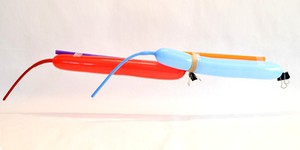Summary
Introduction
If you have wondered how rockets are propelled forward or if you enjoy the excitement of launching a rocket, this is an activity for you! You will learn how to make tiny rockets from aluminum foil and matchsticks, and how to ignite them safely. Soon, you will be launching one rocket after the other! Your challenge will be to find the most reliable launching mechanism.
Materials
- Aluminum foil
- Skewer
- Scissors
- Pencil
- Matchsticks, at least 20
- Pliers
- Ruler
- Large matchbox or another box that is less than an inch high
- Paper clip (without plastic cover)
- Tea light candle with a candle holder or other surface that can support wax drippings, or a multipurpose lighter
- Safety glasses
- Adult supervision when launching rockets
- Optional: tape
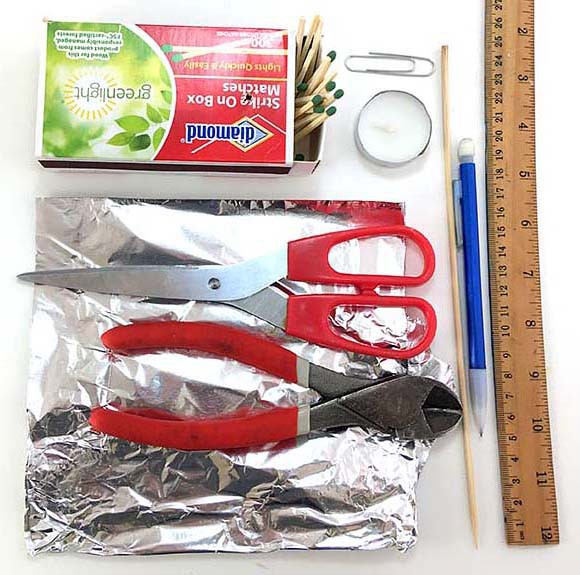 Image Credit: Sabine De Brabandere, Science Buddies / Science Buddies
Image Credit: Sabine De Brabandere, Science Buddies / Science Buddies
Prep Work
Make Rockets:
- Cut 0.5 cm off the pointed end of a skewer. Then trim the remainder of the skewer so that it measures 11.5 cm, keeping the pointed end.
 Image Credit: Sabine De Brabandere, Science Buddies / Science Buddies
Image Credit: Sabine De Brabandere, Science Buddies / Science Buddies
- Cut three 6 cm by 6 cm square pieces of aluminum foil.
- Clip the flammable tips off three matchsticks.
- To make one rocket, align the skewer with the edge of one piece of aluminum foil. Place the skewer 2.5 cm from the top of the aluminum foil, leaving the space above empty.
- Place one matchstick tip just above the skewer, pointing away from the skewer.
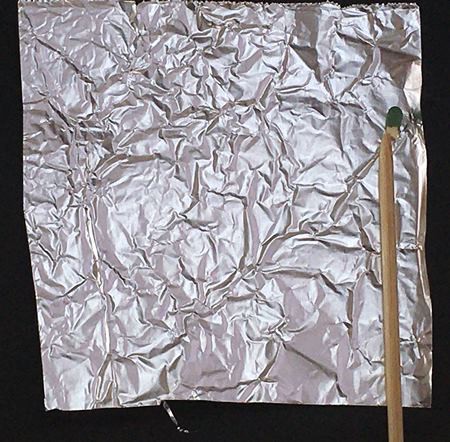 Image Credit: Sabine De Brabandere, Science Buddies / Science Buddies
Image Credit: Sabine De Brabandere, Science Buddies / Science Buddies
- Carefully roll the foil around the skewer. It should be tightly wrapped, but not so tight that you cannot pull the skewer out.
- Pinch the top of the roll — the area without the skewer or matchstick tip — and fold it at least two times, pinching hard to make sure there is an airtight seal.
 Image Credit: Sabine De Brabandere, Science Buddies / Science Buddies
Image Credit: Sabine De Brabandere, Science Buddies / Science Buddies
- Slide the rocket (the aluminum foil roll) off the skewer.
- Repeat steps 4–7 two times, for a total of three rockets. Leave the third rocket on the skewer.
If you accidentally forget to keep one rocket on the skewer, do not try to slide one back on, it is almost certainly going to get damaged in the process. Instead, prepare another rocket that stays on the skewer. You can launch the rockets that are no longer on a skewer with the paperclip launcher.
Make a Paperclip Launcher:
- Lay a paperclip flat.
- Fold the outer loop up so it points about 45 degrees up.
- Bend the free arm of the inner loop to the side so the paperclip can stand up, resting on that loop.
- Use the pliers to clip off a piece of the outer loop of the paperclip so you are left with a straight section pointing about 45 degrees up. This is your launcher.
 Image Credit: Sabine De Brabandere, Science Buddies / Science Buddies
Image Credit: Sabine De Brabandere, Science Buddies / Science Buddies
- Slide a rocket (one that is no longer on the skewer) over the upward facing part of the paperclip launcher.
Make a Box Launcher:
- Use an empty large matchbox or another box that is similar in height, or make a box from cardboard.
- In the top of the box, make a hole just large enough to hold a skewer.
- Slip the end of the skewer through the hole — the rocket will be pointing out. Adjust so it sits firmly.
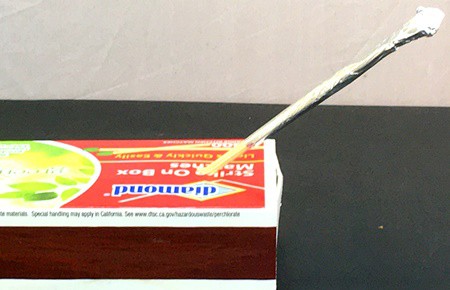 Image Credit: Sabine De Brabandere, Science Buddies / Science Buddies
Image Credit: Sabine De Brabandere, Science Buddies / Science Buddies
Instructions
Launching the Rocket
 Safety Warning:
Safety Warning:
- Only launch with adult supervision.
- Only launch in a well-ventilated area or outside.
- Never launch outdoors when fire danger is high.
- Point the rocket launcher away from people and pets. Expect the rockets to fly several meters.
- Have water or a fire extinguisher ready nearby.
- Everyone should wear safety glasses, including spectators.
- Take the box launcher, skewer, and rocket.What do you think will happen if you heat the tip of this rocket?
- Place your launcher, with the rocket inside the hole, on a surface that is safe for wax drippings.
- Point the rocket so it has plenty of space to fly, and point it away from people or pets. Put on your safety glasses and ask your spectators to put them on, too.
- Make a small platform to put the candle on. Once the candle is lit, its flame should reach the tip of the rocket. You can also use a multipurpose lighter to heat the tip of the rocket.
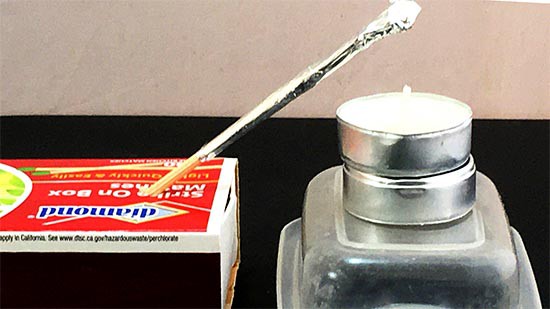 Image Credit: Sabine De Brabandere, Science Buddies / Science Buddies
Image Credit: Sabine De Brabandere, Science Buddies / Science Buddies
- Light the candle and wait for about a minute.What happens? Why do you think this happens?
- If the rocket did not launch, try the following:
- If smoke appeared from the tip of your rocket, the tip was not sealed tightly enough. Make a new rocket and make sure to pinch the top closed tightly.
- After letting your rocket cool, see if it was stuck on the skewer. If so, make a new rocket but roll it up a little less tightly on the skewer.
- If smoke gradually came out from the bottom of the rocket, make a new rocket but roll it up a little more tightly so there is less space for smoke to escape.
- Replace the box launcher with the paperclip launcher and, if it is not loaded yet, load it with a rocket.What do you think will happen if you heat the tip of this rocket?
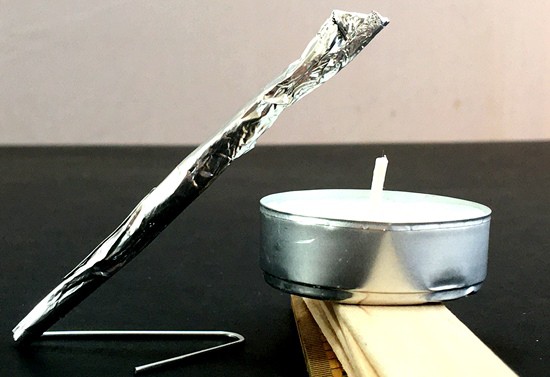 Image Credit: Sabine De Brabandere, Science Buddies / Science Buddies
Image Credit: Sabine De Brabandere, Science Buddies / Science Buddies
- Repeat steps 2–5 using the paperclip launcher.What happens? Why do you think this happens?
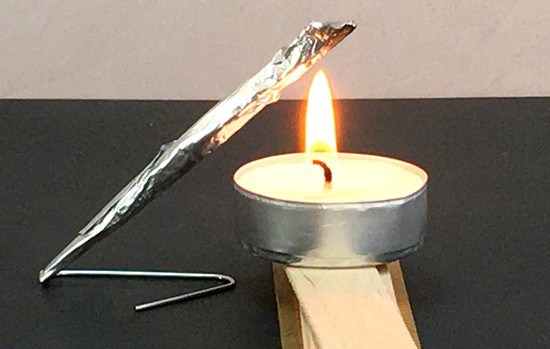 Image Credit: Sabine De Brabandere, Science Buddies / Science Buddies
Image Credit: Sabine De Brabandere, Science Buddies / Science Buddies
- If the rocket is still on the launcher, turn over the launcher to slide the rocket off. Do not touch the rocket, it will be hot.
- Slide the third rocket onto the paperclip launcher. Carefully pinch or twist the bottom end of the rocket so it becomes just a little wider than the paperclip. Do not press or twist too much because the rocket needs to slide easily off the launcher.
- Repeat steps 2–5.What happens? Why do you think this happens?
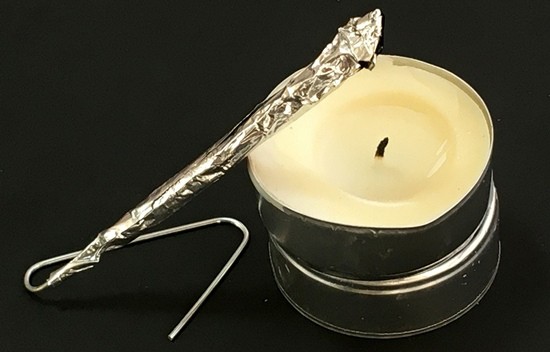 Image Credit: Sabine De Brabandere, Science Buddies / Science Buddies
Image Credit: Sabine De Brabandere, Science Buddies / Science Buddies
- If a rocket did not launch, try the following:
- If smoke appeared from the tip of your rocket, the tip was not sealed tightly enough. Make a new rocket and make sure to pinch the top closed tightly.
- After letting your rocket cool, see if it was stuck on the paperclip. If so, make a new rocket and pinch it very carefully. Test if it easily slides along the paperclip, but do not slide it off as it will be hard to get it back on.
- If smoke gradually came out from the bottom of the rocket, make a new rocket but pinch or twist the bottom of the rocket a little more tightly so there is less space for smoke to escape.
- Rockets do not launch if smoke can gradually escape from the top or bottom of the rocket.Why would that be? Where does the force that launches the rockets come from?
- Make more rockets and repeat the experiment.Can your results be reproduced? Can you explain your results?
What Happened?
The rocket was probably successfully launched using the box launcher. The first trial with the paperclip launcher probably caused a lot of promising smoke but no launch, but the second trial was likely successful.
When the matchstick tip heats, it ignites and creates gases. When the gases cannot escape fast enough, pressure builds up inside the cylinder of your rocket and this pressure eventually pushes the rocket off. The paperclip is very thin. When the cylinder of the rocket is not pinched, there is plenty of room for gases to escape. This prevents pressure from building up, and thus there is no launch. If you pinch the rocket so it becomes only a little wider than the paperclip, gases can no longer easily escape and the rocket launches.
These rockets can still be improved. Fins can stabilize the flight of your rocket, and more fuel can shoot the rocket farther or higher. Increasing the launch angle (pointing the rocket up higher before launch) will make the rocket go higher.
Digging Deeper
Rockets (and jet engines) propel themselves by letting out exhaust gases. It is a nice example of Newton's third law of motion which states that for every action, there is an equal and opposite reaction. You might have seen this law working when you let a balloon go without tying the neck: air escapes through the neck of the balloon (the action) and the balloon is pushed in the opposite direction (the reaction). Rockets are propelled in the same way.
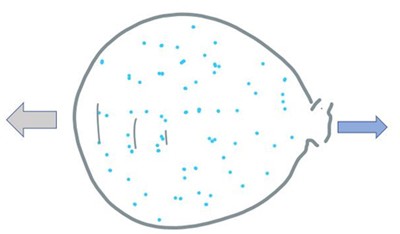 Image Credit: Sabine De Brabandere, Science Buddies / Science Buddies
Image Credit: Sabine De Brabandere, Science Buddies / Science Buddies
Rockets create pressurized gases by burning propellants. Your matchstick rockets use the chemicals in the matchstick tip as fuel. The heat from the candle ignites the fuel and starts the production of gases and smoke. Did you notice that for a successful launch, the release of these gases (the action) coincided with the launch of the rocket in the opposite direction (the reaction)? The body of your aluminum foil rocket acts like the combustion chamber of your rocket. It also confines the gases and smoke. When the pressure becomes large enough, the gases and smoke suddenly stream out (the action) and the reaction launches the rocket.
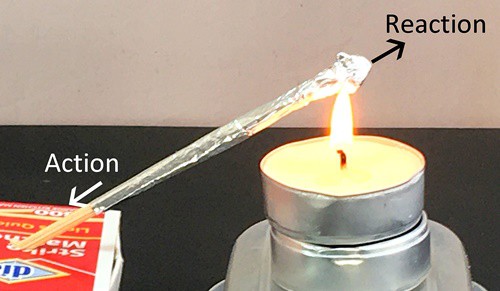 Image Credit: Sabine De Brabandere, Science Buddies / Science Buddies
Image Credit: Sabine De Brabandere, Science Buddies / Science Buddies
The size of the hole through which the gases and smoke escape is crucial for a successful launch. If the hole is too large—as you probably noticed with your first launch on the paperclip launcher—the smoke and gases gradually escape. No pressure builds up and the rocket does not launch. If you reduce the size of this hole, more pressure will build up before the gases and smoke escape. Newton's second law states that the size of the action—and thus also the size of the reaction or the thrust on the rocket—is equal to the mass flow rate (mass per unit time) of the gases that escape multiplied by the speed at which these escape. Does a smaller hole mainly allow the gases to escape with more speed or is the reduction of flow rate the dominant factor? When more fuel is ignited, more gasses (and thus more mass) will accumulate. Does this propel the rocket farther and higher? Try it out!
Ask an Expert
For Further Exploration
- Try to improve your rockets. You might want to add small pieces of tape or aluminum foil tape to the side of the rocket to act as fins, or try using two matchstick tips for fuel. Always predict what you think will happen, test it, and try to explain your observations.
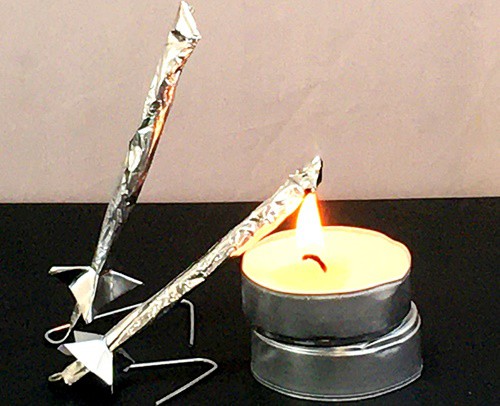 Image Credit: Sabine De Brabandere, Science Buddies / Science Buddies
Image Credit: Sabine De Brabandere, Science Buddies / Science Buddies
- Examine different launch angles. Which angle is best to get the rocket as high as possible?
Related Resources
Project Ideas
Activities
Lesson Plans
- 3-5—Science Practices.
- MS-Science Practices.
- MS-PS2-2. Plan an investigation to provide evidence that the change in an object's motion depends on the sum of the forces on the object and the mass of the object.
- MS-ETS1-3. Analyze data from tests to determine similarities and differences among several design solutions to identify the best characteristics of each that can be combined into a new solution to better meet the criteria for success.


